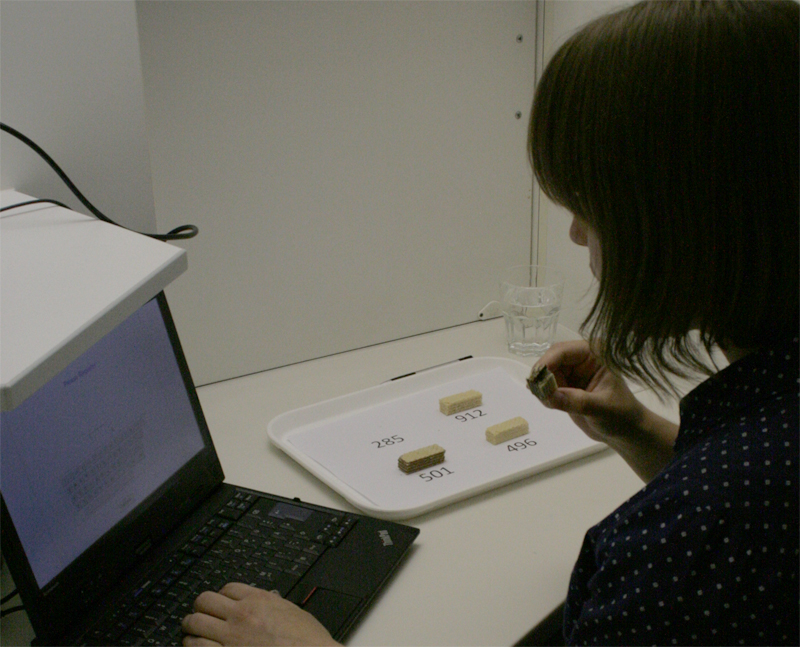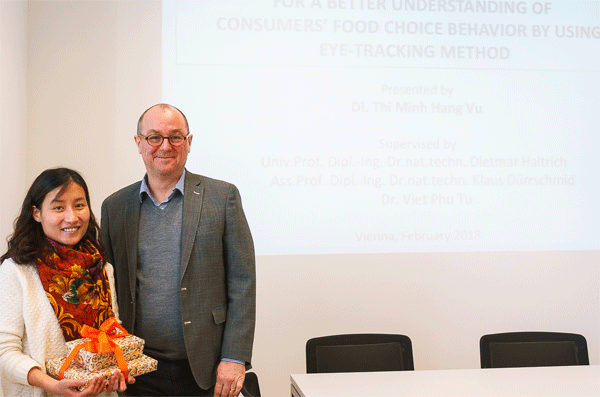Here’s looking at you, wafer
Imagine you are at a buffet, hungry and ready to choose. You gaze over the food, zoom in on one of the dishes, anticipate a delightful treat, grab it and eat it. Yummy! (Or not). Scientists want to take a closer look at this behavior and investigate the processes, from gazing, to wanting, to liking. The goal is to deepen our understanding of how we choose our food.

Austrian wafers, well known in Austria, exotic in Vietnam
Thi Minh Hang Vu and her colleagues from the University of Natural Resources and Life Sciences BOKU in Vienna, Austria asked 242 volunteers from Vietnam and Austria to look at the packages of four kinds of typical Austrian wafers from the Manner company in Vienna. The wafers are a familiar product in Austria, whereas they are unknown in Vietnam. The sweet treats were flavored with either hazelnut, vanilla, or lemon; one treat contained whole grains. The volunteers had to indicate first which product they would like to try the most.
With the help of an eye-tracker, a technological system that follows the movement of the eyes, the researchers analyzed the gazing behavior of the study participants. Subsequently, the volunteers were asked to estimate on a scale from 0 to 9 how much they expected to like the wafer, and – after tasting – how much they did like it.

A study participant tasting and rating the different wafers
Hazelnut versus lemon
The results show that whether or not the participants had prior experience with the food played a role in their behavior. For example, while the Vietnamese participants spent a long time looking at the package of the lemon wafer, the eyes of the Austrian participants spent a short amount of time. The difference between the two groups was also obvious in the wanting of the food. The Vietnamese wanted to try the whole grain wafer the most, the Austrians desired the hazelnut wafer. Whereas the Austrian volunteers showed a difference in expected liking to each of the wafers, the Vietnamese volunteers did not. This did not change after tasting the wafers.
The Austrian participants showed a difference in liking for each of the four kinds of wafers, whereas the Vietnamese participants found no difference among the wafers. The over-all results show that the product that the Austrian participants wanted to try the most was the product that had attracted their attention the most. It also received the best scores in expected liking and liking after tasting. No surprise here! It could be concluded that looking at a product goes hand in hand with wanting as well as with liking the product. Thus, the results of eye-tracking could predict future liking of a product. Yet, the story is more complex.
When expectation and perception don´t match
“The results of the Vietnamese participants surprised us,” explains Thi Minh Hang Vu, who is currently working at the Hanoi University of Science and Technology in Vietnam. “Even though we found a correlation between gazing behavior and wanting to try, there was almost no correlation between wanting to try, expected liking, and liking after tasting.” Some products that were expected to be tasty by the Vietnamese participants failed the taste test, whereas some products that received high ratings on the taste test had received low ratings as to expected liking.
Putting more teeth into sensory science
The study´s co-author, Klaus Dürrschmid from BOKU states that, “The results underline our need to be careful when investigating consumer behavior. We need to look at each link in the chain of consumers´ food choice reactions, from the viewing to the wanting to the expectation to the perception. Cross-cultural research can help us to see which parameters influence these correlations.” A follow-up study, investigating the consumer behavior of Austrians and Vietnamese regarding a typical Vietnamese food product, a moon cake, will be published soon. In this case, the Austrians will be unfamiliar with the product.
Next time you find yourself sampling fried water bugs, steamed squid teeth, and fetal duck eggs (all Vietnamese delicacies), keep in mind that your expectations might not match your experiences. When you chew on the squid teeth, you may well experience a strong hedonic contrast, and it may turn out to be a pleasant surprise.

Klaus Dürrschmid congratulates Thi Minh Hang Vu after she successfully defended her doctoral thesis in Vienna, Austria. The wafer study was part of her doctoral thesis.
Source: Gazing behavior reactions of Vietnamese and Austrian consumers to Austrian wafers and their relations to wanting, expected and tasted liking Thi Minh Hang Vua, Viet Phu Tub, Klaus Duerrschmid ![]() Food Research International 2018 (in press)
Food Research International 2018 (in press)
Photos (from top to bottom): fotolia - sasajo, Thi Minh Hang Vu, Klaus Dürrschmid